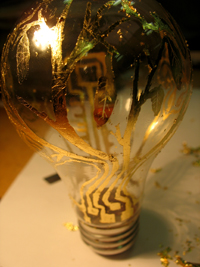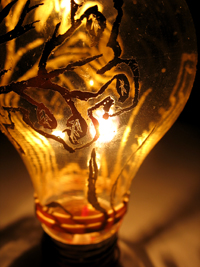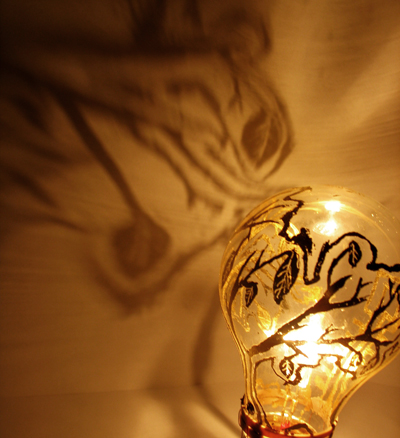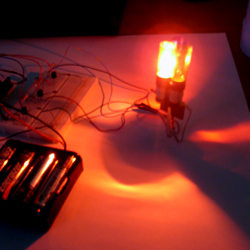My proposal can be found here :
November 5, 2007
September 12, 2007
A useful website for understanding circuits
This is a simple website that explains how many circuits and components work.
Hope it’s useful to somebody.
touch

This Light reacts to a person touching it’s surface. Circuit traces printed across the surface of the lamp detect the resistance of the users finger and reacts by brighting or dimming the light.
This circuit uses two transistors in a Darlington pair to detect the slight bit of current that is allowed to run from a circuit trace to ground when a user touches the circuit. The chip then detects whitch circuit trace has been touched and changes the PWM signal on a pin accordingly to dim or brighten the light.
The PWM pin it attached to a large transistor that pulses a 12volt line that is applied to the Halogen bulb. the 5v arduino is just used to turn this transistor on.
check this page for lots of useful information and to find out how a Darlington pair works http://www.kpsec.freeuk.com/trancirc.htm
September 10, 2007
Ok it might not be furniture and its debatable weather or not it interactive, But people might be interested in looking at a very talented kinetic sculptor for inspiration. Theo Jansen

Theo at TED talks, long but worth watching.
September 6, 2007
What is interactive Furniture?
“iBar is a system for the interactive design of any bar-counter. Integrated video-projectors can project any content on the milky bar-surface. The intelligent tracking system of iBar detects all objects touching the surface. This input is used to let the projected content interact dynamically with the movements on the counter. Objects can be illuminated at their position or virtual objects can be “touched” with the fingers.” from iBar
comment What I find interesting about this piece is how the context of the place influences the design, how objects used in the space for example glasses are used as part of the interaction and how the design enhances interaction between people in that space and provides a new and possibly less scary way to make social connections with strangers in that space.
“The four FRONT members have developed a method to materialise free hand sketches. They make it possible by using a unique method where two advanced techniques are combined.
Pen strokes made in the air are recorded with Motion Capture and become 3D digital files; these are then materialised through Rapid Prototyping into real pieces of furniture.” from frontdesign
comment Is this interactive furniture? I find it interesting that in this design your interaction with a environment directly influences the furniture it’s self. In this design the interaction is intentional and you directly sketch the furnitures form, but could this process be more abstract where a interaction with a environment or piece of furniture only influences the furnitures form or influences the design of a piece of furniture that is fabricated later.
“designed by nina farkache, 2001 for droog design. wanting to have people get closer, the ‘come a little closer’ bench was designed so that when you sit on it, you cannot avoid making contact with another person. the discs slide over the rolling marbles, which allows people to play, which in turn can bring them closer together. made of steel, glass and MDF, ‘come a little closer’ comes in a 3 seater and a 5 seater.”
“come a little bit closer”
September 5, 2007
cameleon lamp
Concept: To design a light that mimics a color if shown to it. Design: lamp driver. LEDs are very efficient as they only emit one frequency of light, and because of this the light produced could be perceived as flat and lifeless. Instead i used tungsten bulbs because unlike LEDs they aren’t flat and lifeless. Because the Arduino cannot provide enough current to power a tungsten bulb without damaging the Arduino chip, I had to use transistors to turn a separate power source on to power the bulbs. This also meant that the lamp wouldn’t draw too much current from the laptop. To do this i connected the pwm pins to base of the transistors, and grounded the transistors to the Arduino’s ground in series with diodes to prevent current flowing back through the tungsten bulbs from the Arduino. Because i used the pwm pins i could dim the bulbs the same way one can dim LEDs in the Arduino code.colour sensor. Because I wanted the lamp to detect colors and mimic them, I prototyped a simple color sensor. To do this i connected three light dependent resistors (LDR’s) to the analog inputs of the Arduino, with a 10kohm resistor between them and ground to create a light-dependent voltage divider. I covered each of the LDR’s with a piece of red, green, and blue transparent plastic respectively. This meant that when light of a certain color fell on the LDR’s, it would be absorbed and measured differently by each of them, respective to color. Thus, a color value could be interpreted from the LDR’s and replicated with the tungsten bulbs.notes. At the moment, the color sensor only works effectively when a piece of cellophane is held over the sensor to color the light. In further development a lens could be used to focus images onto the color sensor, thus obtaining a more accurate color value.

















